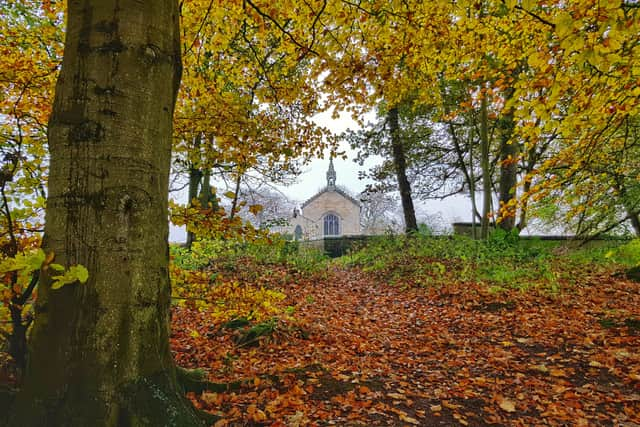The Dunino Den: Ancient Scottish druid site where stonework tells of an unearthly past


Nestled in the East Neuk of Fife a mere ten minutes away from St Andrews (Scotland’s famous home of Golf), visitors may stumble upon Dunino village which is often overlooked. As a Scottish peninsula with hundreds of communities under its name, this unsuspecting parish may seem like any other but is home to an ‘unusual’ strip of natural woodland where a pre-Christian holy site resides alongside Kinaldy Burn; the Dunino Den.
Tucked away behind Dunino Abbey in this woodland clearing, the location is known for its supernatural atmosphere which is tied both to Scottish folklore and its very antiquity. In fact, the nearby graveyard has an archaic stone sculpture which researchers have connected to a Neolithic stone circle - suggesting that this place has been significant since the Pictish era.
Advertisement
Hide AdAdvertisement
Hide AdTo enter, intrepid wanderers must descend down the winding staircase that leads to the eerie locale which is covered in cryptic symbols, religious carvings and humble offerings which are left by Pagan worshippers seeking to appease spirits. While the scenery is captivating, believers urge visitors to consider the nature of spirits that lurk here given that the Dunino Den was a site where ancient Druids were said to commit human sacrifices.
With a heritage that spans druidry, the Picts and even early Christian worship, centuries of history are reflected by the enigmatic carvings that are tucked in every corner of the place.
Here is an overview of this hidden gem that is highly recommended for those visiting Scotland especially close to Fife.
What is the Dunino Den?
Located behind Dunino Church, the den is a mysterious spot which is thought to have been a Pagan place of worship prior to the arrival of Christianity in Scotland - historians have also described it as an ‘ancient ceremonial site’ for Druids. Here, we find the fabled Altar Stone which has a footprint embedded into it.
It is thought to have been used to crown Pictish Kings. As the Welcome to Fife website explains: “Carved footprints were used during inauguration rituals, such as the anointing of kings.”
More disturbingly, however, experts suggest that human sacrifices by the Druids took place on the same stone. Another crag (a word anglicised from the Gaelic for a rocky outcrop) is the “Pulpit Rock” which some say was the site where Christian monks would plant their wooden cross.
Heading down the winding set of steps carved into the rocks we find many etchings such as Celtic crosses, human faces and other ‘mystical’ symbols. Many offerings have been left in the cavities of the rock face such as coins, ribbons (also known in Scots as “cloots”), jewellery and even undergarments.
It is believed that these are offered to appease the fairies that lurk here (those familiar with Scots mythology understand that such spirits can be intensely violent.) Intriguingly, this ties into the lore that describes Druids as ‘descendants’ of fairies.
Why is the Dunino Den so called?
Advertisement
Hide AdAdvertisement
Hide AdThe LearnGaelic Dictionary claims that Dunino translates to Dùn Aonaich in Scotland’s native Celtic language; Scots Gaelic. Broadly speaking, the “‘Dùn” (Fort) and “Aonaich” (Assembly) have led etymologists to decipher the name as ‘Fort of the Assembly Place’.
However, for those that know how to read a Scottish map, it is well known that anglicisation of Celtic languages is inconsistent and there are often many interpretations for place names.


History of the Dunino Den
According to the McCulloch House Museum & Genealogy Centre: “Druidry, or better termed Druidism, was a pagan spiritual practice that is used to bring harmony, reverence, and spiritual connection between humans and the magic of nature.”
They continue: “The first Scottish Druids were men in the 4th and 5th centuries, but later became practiced only by women from the 13th century onward.
“When female Druids became known, many people referred to them as fairy worshippers or witches.”
Curiously, this ties into the theory that the name “Dunino” is from the Gaelic “Dunnigheanach” which means ‘Fort of the Young Women’ or ‘Maidens’. Many reports claim that the Dunino Den is at least 2,000 years old and it remained in use until the 7th century AD when Druidry was driven underground by Christian missionaries.


How to get to the Dunino Den
Dunino Church is located three miles south-east of St Andrews, motorists can follow directions to arrive here before using the church parking. Once parked, if you leave the church to your left and follow the trail that leads through the cemetery you will eventually descend into the woodland.
Carry on straight for a few minutes before you see the Altar Stone, to its left are the winding steps that take you to the heart of Dunino Den. Do be careful as the ‘staircase’ is both steep and often slippery (and certainly enough blood has been spilt on this historic site as is!)
Comments
Want to join the conversation? Please or to comment on this article.
